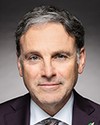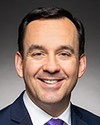Madam Speaker, I move that the 13th report of the Standing Committee on Veterans Affairs, presented on Thursday, November 9, be concurred in.
I have been working on this file, the national monument to Canada's mission in Afghanistan, since September. I had the pleasure of asking my first question on the subject back in September, during our first week back in the House after Parliament resumed. Since then, a lot has happened, and there are new developments every week. I can assure members that the Bloc Québécois will not back down on this terrible injustice.
Today, I am here to try to shed some light on what really happened and demand that a terrible injustice be corrected. For those of you who have absolutely no idea what we are talking about here, I will give a brief overview.
The government held a public art competition to select a design concept for the national monument to Canada’s mission in Afghanistan. There was a bidding process. The government put together a jury of experts to select the winning team. The jury, composed of experts with international experience, spent hundreds of hours evaluating the proposals and unanimously decided that the winning team was the one made up of architectural firm Daoust Lestage Lizotte Stecker, artist Luca Fortin and strategic advisor Louise Arbour. Obviously, this team is from Quebec.
To everyone's great surprise, the government ended up ignoring the jury's decision and giving the contract to a different team, one from Alberta and Ontario. This is a small $3‑million contract. Let us travel back in time to take a close look at exactly what happened, when it happened and how it happened.
Our combat mission in Afghanistan lasted from 2001 to 2014. It involved Canadian Armed Forces, obviously, as well as police, public servants and civilians.
In August 2019, the Minister of Veterans Affairs and the Minister of Canadian Heritage and Multiculturalism launched the first step of a call for tenders. In August 2020, the five teams of finalists who would prepare design concepts for the monument were revealed.
Now, let us skip forward a bit to late May, early June. The government conducted an online survey, open to the public, to receive comments on the five projects, the five designs on the table. The government's news release said, “The jury will consider the survey responses in selecting the winning design. This winning design will be announced this autumn.”
To this point, it appears everything was done by the book; nothing was amiss. The veterans, their families and Canadians were consulted before and during the competition. Veterans' wishes and concerns were included in the bidding rules so the jury would consider them in their free and informed decision. It was clear: The expert jury would be the one to choose the best project, and they would also take into account the survey results and the comments of a technical committee. The weight of the jury would be 70% and that of the technical committee 30%.
The survey consisted of a 90-second video with a number of images of each project. Again, to this point, nothing was amiss, and the government took steps in the survey design to ensure equality of voices. An email from the Department of Veterans Affairs dated November 17, 2021, concerning the survey states as follows: From the outset, the consultations regarding the national monument to Canada's mission in Afghanistan were designed to be broad and not preferential. All voices and opinions are considered equal. It would be highly irregular for the survey process to give more weight to the voice of one group over another. Such preferential treatment was never discussed at any time while developing the project.
Let us skip forward again, to November 2021.
The departments of Canadian Heritage and Veterans Affairs Canada were informed of the jury's unanimous decision. The jury of experts decided that the Daoust team had won the competition. There was no question that the jury had reached a decision and the Daoust team was the winner. Once again, the jury was made up of seven members from across Canada, including four people who were directly or indirectly involved in Afghanistan.
The Daoust team and members of the jury were informed of the ultimate outcome just two hours before the press conference on June 19, 2023. Two hours before the press conference, the winning team found out that it was not the winner after all and that the winning monument was one submitted by another of the five finalist teams.
What happened between November 2021 and June 2023 to make the government decide to overturn the jury's decision?
We know that in the winter of 2022, the Department of Canadian Heritage asked the Department of Justice for a legal opinion to assess the risks. The 400 pages of documents we have received in recent weeks do mention “risks”. In my view, that is the first admission of guilt. We also know that the government offered to compensate the Daoust team for what it calls a loss of income. The understanding is that that team won but was stripped of the prize and the right to create the monument. Because the firm will lose money for this process, which will no longer take place, that has been deemed a loss of revenue and the firm has been offered a sum of money. This is the government's second admission of guilt.
Would the government have asked for a legal opinion and offered money to a team if it had acted legitimately? I think the answer is quite simple.
The competition rules state that “the Minister of Canadian Heritage, as minister responsible for commemorative monuments on federal lands...and the Minister of Veterans Affairs...will be jointly responsible for endorsing the jury's selection of the winning design”. In the eyes of the law, they were responsible for endorsing the jury's selection, not changing it, let alone cancelling it. Doing so goes against the government's own process.
How does the Minister of Veterans Affairs justify this?
First they said they wanted to choose a design that better represented the views of veterans and their families. The most popular design among veterans who responded to an online poll was selected.
I commissioned a small analysis. Actually, it is not small. In any case, the bill was quite large. I commissioned an analysis by the polling firm that everyone knows, Léger, the biggest polling firm in Canada. I forwarded the poll that the government sent to roughly 10,000 people to the firm. It confirmed that all the results were compromised and that there was nothing usable in this pseudo-poll. There is no way to verify the identity of the people who responded to the poll. We do not even know if a single woman responded to the poll.
As I was saying earlier, we received emails from the government over the past two weeks. The Department of Veterans Affairs knows full well that it cannot rely on online surveys. It said so itself in black and white. Here is an excerpt:
The survey was designed to collect aggregate data, not segmented results....The demographic data cannot be clearly broken down. Some respondents identified as belonging to several categories, for example, a soldier, a family member and a member of the public.
This clearly shows that the survey does not in any way represent what veterans really think. It does not represent much of anything really, contrary to what the current Minister of Veterans Affairs has said several times.
That is one of the many reasons why the Daoust team was chosen. “The Daoust team’s proposal best reflects...the fact that the sacrifices made by the Canadians…who participated in the mission were not in vain, especially [as concerns] the education of women and girls in Afghanistan.” For Canada, this was not a war mission, in principle. We went to support and help the Afghan people.
The reasons given by the government to justify pushing the Daoust team aside and choosing the Stimson team just do not hold water. What is the reason behind it? How come the government pulled out of a hat that the winner would not be the Daoust team but rather the Stimson team? I think we all agree; it is not hard to grasp that the decision came from high up and there was interference. At the moment, there is no other credible explanation.
First, when I questioned the Minister of Veterans Affairs to find out if the decision had come from her department or from the Prime Minister’s Office, she replied, “The decision…comes from our government.” She was not sure whether the Prime Minister’s Office had intervened. She told me she would ask the question, which is not very reassuring.
Then, I asked her the question a second time at the Standing Committee on Veterans Affairs, and the answer had changed. She informed me that the recommendation to choose the Stimson team and push the Daoust team aside had come from the Department of Veterans Affairs. Deciding to take the blame was something she chose to do.
Second, the Minister of Canadian Heritage, Ms. St-Onge, tried to downplay the role of her department, saying that it was the Department of Veterans Affairs that was in charge of the project. We all know, however, that the project was jointly put together by the departments of Veterans Affairs and Canadian Heritage.
Then we learned in a document obtained through the Access to Information Act that the Department of Veterans Affairs needed the Minister of Canadian Heritage’s signature to be able to push the Daoust team aside. Both ministers have been passing the hot potato back and forth and continue to do so. This document signed by the Minister of Canadian Heritage is dated May 2023. This is a process that ran from November 2021 to May 2023.
Why were the jury and the Daoust team notified only two hours before the official announcement? Obviously, it was to ensure they could not react. They were faced with a fait accompli.
It will come as no surprise that I do not have enough answers for my liking in this file. Because I did not have enough answers, I suggested that we invite witnesses who are all public art experts to the Standing Committee on Veterans Affairs.
First, we heard from Jean-Pierre Chupin, a university architect and holder of the Canada Research Chair in Architecture, Competitions and Mediations of Excellence at the Université de Montréal. He confirmed that it would be a first in Canadian history to overturn the jury's choice and select another team. This has never happened before. Then he referred to 500 competitions he has documented. He said the following:
All the studies show that, in judging the complexity of...projects, such as public buildings and monuments, a popular vote will never be as reliable, fair or transparent a procedure as a well-organized competition procedure. A competition jury is analogous to a court jury. It represents the diverse range of public interests and works in a rigorous manner.
Let me quote another witness, François Le Moine, a lawyer specializing in art and heritage law and president of the Association littéraire et artistique internationale Canada. Mr. Le Moine is an authority on copyright and all things relating to art and heritage buildings. He said, “Under the rules of this competition, the government simply did not have the necessary leeway to award the contract to a team that had not been selected. It is the jury that makes the decision, not a minister”, and not a prime minister. If the withdrawal from Afghanistan in the summer of 2021 did indeed change the equation, as the Minister of Veterans Affairs claimed, then there was only one option: cancel the competition. This is clear from the decision tree the government provided. It could either approve the jury's choice, or it could rerun the competition. In the documents issued to bidders, no third option is possible.
The lawyer, Mr. Le Moine, continued, “the only solution available to the government was to cancel the competition and organize another”. The government should have cancelled and started over. However, this was never discussed. At any rate, in the 400 pages of documents we received, there is no mention of cancelling the competition. According to Mr. Le Moine, “[w]hat is at stake is much more than just the matter of public art; rather, it is the integrity of [the public contracting process and the accountability of our leaders]. A political system based on the rule of law requires both the governed and the governing to follow the established rules”. Let me go over that again. The government initially established perfectly credible and valid rules that complied with the appropriate procedure for a public call to create a work of art on this scale.
After hearing these experts testify, I moved a motion at the Standing Committee on Veterans Affairs asking that all documents exchanged between the departments and the Prime Minister's Office be disclosed. We received the 400 pages I mentioned earlier. Surprise, surprise, dozens and dozens of pages were redacted. However, there is one interesting point they may have forgotten to redact. The emails show that the Prime Minister's Office asked for a meeting between four parties about the Afghanistan monument, the four being the Privy Council Office, Veterans Affairs Canada, Canadian Heritage and the PMO. Then, in June 2022, after those four met, the PMO asked the public servants responsible if things were moving along. If anyone does not know what PMO means, it stands for Prime Minister's Office.
Here is what the two ministers refused to tell us when we had them come to the committee. The Prime Minister's Office was involved. We have written proof in two of the documents we received. The Prime Minister intervened in the process. He held a meeting about the monument and then pressured both departments for information about how things were progressing. Why did the ministers try to hide the PMO's interference? Was it because the decision to reject the Daoust team and give the contract to the Stimson team was made by the Prime Minister's Office? That is what the documents suggest, those that are not redacted, anyway. Many questions remain unanswered, but the big one for me is this: Why did the Prime Minister's Office decide to intervene in this competition?
Why did the government lie to us by saying that it chose to give more weight to the survey because of the situation in Afghanistan when—











